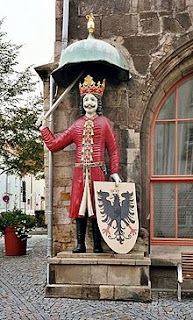 I
was born in Nordhausen, a city in the state
of Thueringen (Thuringia) in Germany. When I lived there we always would refer
to the Harz-Mountains which are north of the city. I lived there when Nordhausen was part of the
DDR or East-Germany. My dad owned a
Jewelry store which he had built based on his training as a watchmaker and his
drive to be a business owner. When in
1961, he was notified, that he would have to surrender his ownership to the
state, he decided to close the doors himself, and leave his business as well as
all other personal property, except for a few suitcases, behind. With four children in tow he and my mother
managed to bring us all safely through Berlin into the Western sector where we
registered as refugees.
I
was born in Nordhausen, a city in the state
of Thueringen (Thuringia) in Germany. When I lived there we always would refer
to the Harz-Mountains which are north of the city. I lived there when Nordhausen was part of the
DDR or East-Germany. My dad owned a
Jewelry store which he had built based on his training as a watchmaker and his
drive to be a business owner. When in
1961, he was notified, that he would have to surrender his ownership to the
state, he decided to close the doors himself, and leave his business as well as
all other personal property, except for a few suitcases, behind. With four children in tow he and my mother
managed to bring us all safely through Berlin into the Western sector where we
registered as refugees.
For
many years I had dreams, roaming around my hometown. We had left quite suddenly, not telling
anyone, leaving our friends and neighbors without a clue. At the time I didn’t understand why we had to
leave. Then on August 13, 1961, a wall was built in Berlin, which created a
more permanent separation between the two countries. I could only be grateful
to my parents to have the foresight to bring us to freedom and give us a better
future.
In
the meantime, I have gone back to Nordhausen several times. First, I just wanted to see all familiar
places, like the house we lived in, walk the well-known streets, and see the
locations where we played. I even could
share some cherries from the garden my parents cultivated with my children.
Nordhausen
is in many ways a
significant city. It was first mentioned
in a document on May 13, 927. A distinctive
landmark is a Roland statue, which represents a middle-age knight and symbolizes
freedom, power, and jurisdiction. He is
holding a sword in one hand and the coat of arms with a crowned black eagle in
the other. Since the statue was one of
the few remaining landmarks surviving WWII, we celebrated in the 1950s each
year the Roland with a parade.
Nordhausen
was over many hundred years an important economic region of the South-Harz
Mountain. The city experienced many
devastating catastrophes including fires, famines, and the difficult years of the
plague. None of them were as bad as the damage of the bombing at the end of
WWII. With the destruction of 85% of the
city the whole city image was changed.
Not until the re-unification of Germany in 1989 came the city to new
life. In 2004 Nordhausen became the
center of the “2nd Thüringer Landesgartenschau.” Through this event
Nordhausen was transformed into its new glory with flowers, landscaping and
restoring many of the old ruins into beautiful works of art.

Nordhausen
was once known for its tobacco industry, especially chewing tobacco. It is
still famous for the distilled spirit “Nordhäuser
Doppelkorn” which is made from fermented rye, containing more than 37%
alcohol.
I
believe that the city had to pay a high price for the atrocities happening
before their very eyes (maybe hidden in the underground of the Kohnstein
Hills). To restore this, the city faced
not only the bombings of WWII but also 40 years (from 1949-1989) under the
East-German regime.
When
I met my class mates at the class reunion on May 4, 2013, I became very
inspired that I saw people who were not only survivors but even at their
advanced age believed in their city.
They were people who still had spunk and were proud to have lived
through it all by reinventing themselves many times, by adjusting to new work
environments, different ownerships, and even retraining in a different branch
of occupation. They didn’t take anything
for granted but rather were willing to work hard and to roll up their sleeves
many times, just like their parents did after their city was destroyed.
Even
though I didn’t live there for the past 52 years, I feel like I have taken away
the same willing spirit in me. We sure
can never forget where we came from.




1 comment:
I'd love to go back to Nordhausen again sometime. I'm glad you had the opportunity to go to your class reunion and visit your hometown.
Post a Comment